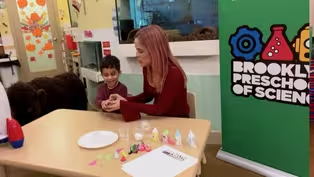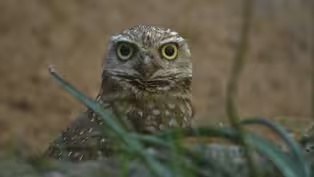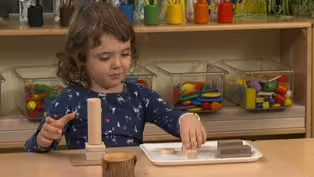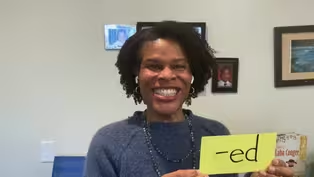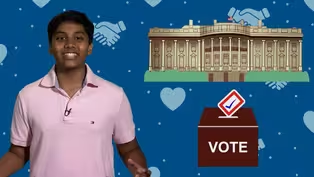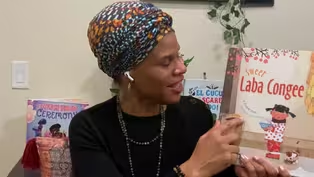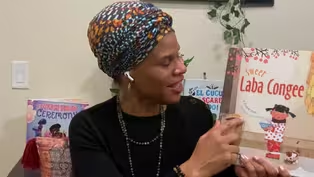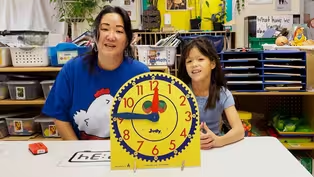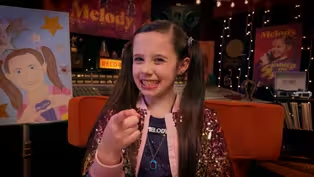
DO YOU HEAR THE “ED” IN MELTED?
7/15/2024 | 55m 54sVideo has Audio Description, Closed Captions
LET'S LEARN together! Solve "The Case of Gone Gratitude." Make a rocket blast off.
LET'S LEARN together! Solve “The Case of Gone Gratitude.” Make a rocket blast off and a wooden sculpture. Meet a youth helper and some owls. Tell time and learn words that end in "ed." Read SWEET LABA CONGEE. One-hour programs help children ages 4-7 learn while having fun. Content provided by Brooklyn Preschool of Science, Dancing Classrooms, Houston Zoo, Meet the Helpers, Studio in a School.
See all videos with Audio DescriptionADProblems playing video? | Closed Captioning Feedback
Problems playing video? | Closed Captioning Feedback
Let's Learn is a local public television program presented by THIRTEEN PBS

DO YOU HEAR THE “ED” IN MELTED?
7/15/2024 | 55m 54sVideo has Audio Description, Closed Captions
LET'S LEARN together! Solve “The Case of Gone Gratitude.” Make a rocket blast off and a wooden sculpture. Meet a youth helper and some owls. Tell time and learn words that end in "ed." Read SWEET LABA CONGEE. One-hour programs help children ages 4-7 learn while having fun. Content provided by Brooklyn Preschool of Science, Dancing Classrooms, Houston Zoo, Meet the Helpers, Studio in a School.
See all videos with Audio DescriptionADProblems playing video? | Closed Captioning Feedback
How to Watch Let's Learn
Let's Learn is available to stream on pbs.org and the free PBS App, available on iPhone, Apple TV, Android TV, Android smartphones, Amazon Fire TV, Amazon Fire Tablet, Roku, Samsung Smart TV, and Vizio.
Providing Support for PBS.org
Learn Moreabout PBS online sponsorship- [Presenter] Ready to learn?
- I have with me here my friend... - Malena!
- [Presenter] It's time to share a story, read and write.
- What's this word going to be?
- [Presenter] Discover science, sing.
♪ How you gon' clean up the Earth ♪ ♪ If you don't clean your room ♪ - [Presenter] Play and so much more.
- We solve- - [Both] Word mysteries!
- [Presenter] Stay tuned for lessons and activities.
[children giggling] [bright music] Funding for this program was provided by the JPB Foundation.
[bright music continues] - Did a word that's important to you go missing?
- And now all you can feel, do, or think is the opposite of that word?
- Then call us!
I'm Sly.
- And I'm Gabby.
We're word detectives and we solve- - [Both] Word mysteries!
- Together, we run the Wordsville Online Detective Agency.
- We'll find your missing word fast.
- Not to mention briskly.
- And swiftly.
- Yeah, we're really good with words.
- [Children] Wordsville!
- So you haven't said anything about the recipe I sent you.
How is it?
- It's soup.
I said thank you when you sent it, didn't I?
- Still nice to hear if you liked it.
- You used my book as a coaster?!
But I thought you were grateful I lent it to you?
- I was grateful, but now I'm not.
- So we're both feeling ungrateful?
Which is weird.
Could this be a- - Word mystery?
Singer Melody's calling.
- Word Detectives, it's terrible!
- What?
- What?
- I have no fan mail and I'm missing a thank you card with the word gratitude on the front.
I liked it so much I took a photo.
See?
But now [sobs].
- The dictionary says gratitude is the feeling that you wanna thank someone because of something kind that they've done.
- So without gratitude, no one feels like saying thank you.
- This is a word mystery, all right!
Singer Melody, tell us what happened and I'll animate it.
Recap time!
- [Singer Melody] Well, I was super busy writing this song for my amazing fans when Artist Clay came in with a portrait of me.
He also offered to fix the purple paint on my wall.
It was peeling.
Then Athlete Glory came in.
She wanted to show me a trophy she had won with the basketballs I donated to the gym and some exercises she had worked on for me.
But I was super busy writing a song, so I asked them to wait.
Before I could talk to them, they left and my gratitude card was gone too.
- Interesting.
Can you show us the scene of the mystery?
- [Singer Melody] This is where I last saw my card.
- [Sly] I'll take a screenshot for our case notes.
Don't worry Singer Melody, we'll solve this.
- Be quick about it, will you?
I need my fan mail!
- She could have said thank you.
- Actually, she couldn't because someone took her gratitude card.
- [Sly] Oh right, that's what happened.
Now we all feeling ungrateful!
- Her recording studio is where it happened, and the card was taken when Artist Clay and Athlete Glory came over.
They're our suspects.
Now to investigate who did it, how and why.
Let's go over clues from the scene of the mystery.
- There's a Singer Melody portrait with a trophy sticking right through it.
It's hard to miss.
- Singer Melody said Artist Clay brought her a portrait.
Let's start with him.
- Hey, Word Detectives.
- Hello.
What happened when you visited Singer Melody today?
- I wanted to give her a portrait I had made of her.
It was my way of saying thank you for her music, which inspires me.
- Did she love it?
- I still don't know.
As I waited for her to look at it, I repainted the peeling purple paint on her wall.
- That was nice of you.
- It was.
Athlete Glory came by to see her too.
But Singer Melody was super busy, so she never even looked up.
Athlete Glory and I gave up waiting, put our things down on a table and left together.
- Hmm.
What are you painting now?
- Nothing.
- Huh?
It's very dark.
Well, bye!
- Leaving without thanking me for my time?
So ungrateful.
- Oh, okay.
Artist Clay did something nice by repainting Singer Melody's wall.
- Would he then do something not nice, like take her gratitude card?
- I'm not sure.
Let's hear what Athlete Glory has to say.
- Oh, hi Word Detectives.
- Are you shooting the basketball Singer Melody donated to your gym into the trash?
- I think it's pretty obvious that's exactly what I'm doing.
I was grateful to her, but not anymore.
Not since I visited her.
- What happened?
- I went there to thank her for the new basketballs and showed her the trophy we won with them, but Singer Melody never looked at me, not even to see the new cardio exercises I came up with to help with her high energy performances.
She said she was super busy.
- Did that make you super sad?
Sad enough to take her gratitude card?
- No.
I put the trophy on the table so she could see it later, said goodbye to Artist Clay and left.
- Well, don't worry Athlete Glory.
We'll solve this word mystery for all the people in Wordsville!
- Whatever.
- No one seems grateful for our hard work trying to solve this word mystery!
- I feel you partner, but we don't solve word mysteries for the thank yous.
- I know.
It's what we do.
Let's go over our case notes.
Artist Clay painted Singer Melody's portrait and repainted her purple wall for her.
- And Athlete Glory came up with exercises for her and brought a trophy for her to see.
- [Sly] But Singer Melody was super busy and kept both suspects waiting so long they left.
Athlete Glory said she put down her trophy and said goodbye to Artist Clay, but he said they left together.
That's strange.
Wait, the portrait is on top of the trophy, which means- - It was put down after the trophy.
Not at the same time!
- And there are purple thumbprints on it.
You thinking what I'm thinking?
- I sure am Sly, I sure am.
- Now presenting the word mystery animated reenactment of The Case of Gone Gratitude.
Hi Singer Melody.
Look, I painted your portrait to say thank you for the way your music inspires me.
- Just a minute.
I'm super busy writing a song.
- I'll just repaint this purple wall while I wait.
- Singer Melody, I'm so grateful for those new basketballs you donated.
Look what they helped us win.
Just a minute.
Still super busy.
Okay, I also came up with some new exercises for you, but I'll wait till you're finished.
She's still too busy?
Oh, I guess I'll just go.
- Somebody needs a lesson in gratitude.
- Did you say something?
Super busy over here!
- Artist Clay is who did it!
- [gasps] Artist Clay?!
- How could you do this to me?
- He grabbed the gratitude card after Athlete Glory left.
That's how.
- It's true.
Singer Melody didn't bother to look at my portrait or Athlete Glory's trophy.
She wasn't acting grateful.
And that hurt.
- I understand.
I felt hurt too.
- I wanted Singer Melody to know how that feels, which is why I took the card.
But I did something not nice when I really just wanted to do something nice.
I'm sorry.
- I'm sorry too.
I was grateful, but I was so busy writing a song for my amazing fans that I guess I forgot to say it.
But that gives me an idea for a song I'll sing for you all when gratitude's returned.
- I'll bring the card back right away and fix your portrait.
♪ Thank you for all that you do ♪ ♪ Yeah I'm so, so grateful I've got you ♪ ♪ Yeah you ♪ - Yes!
- Yeah!
- That was amazing.
- I feel the same way.
I better get those basketballs out of the trash.
- And thank you Word Detectives.
- Thanks Word Detectives!
- And I just wanna say thanks for lending me your book.
It's great.
- And thank you for the delicious soup recipe.
You know what, I'm really grateful for?
- What?
- You.
- Me too, partner.
[bright music] - Hi friends!
It's Isabel and welcome to my reading nook.
Today we're going to be reading a story called "Sweet Laba Congee," written by Qiusheng Zhang and illustrated by Chengliang Zhu.
This is a story about a family that makes a special type of dish, a porridge called congee for the Laba Festival.
This is a tradition in China.
Traditions are customs or beliefs we follow.
In the United States, some of our traditions might be, depending on if you celebrate them, Christmas or Kwanza or Hanukkah.
Those are examples of traditions that we carry on in our family.
And as we read today, I want you to think about her traditions and what your traditions might be.
"Sweet Laba Congee," by Qiusheng Zhang, illustrated by Chengliang Zhu.
My name is Yan'er.
Our house is at the east end of the village in a valley.
A valley is a lower area of land surrounded by hills or mountains.
Our neighbor's homes are called the Zhang Family Compound, the Li Family Compound, and the Zhao Family Compound, while our home is called the Red Persimmon Compound because of the big persimmon tree in our yard.
According to tradition, every family cooks Laba congee during the Laba Festival on the eighth day of the 12th month of the lunar calendar.
The day before the festival this year, Grandma and I sat under the persimmon tree, organizing the ingredients for this tasty porridge.
I wonder what goes into a porridge?
We prepare a wide variety of ingredients, such as rice, sorghum, corn, millet, and chestnuts, walnuts and dates.
It was a lot of work to gather and clean all the ingredients.
On the morning of the Laba Festival, I woke up to the familiar smell of the congee.
Rolling out of bed, I ran to the kitchen and helped mom add firewood to the wood burning stove.
We had a gas stove at home, but grandma insisted on using the wood burning stove and a large pot for making the Laba congee because this was the only way to guarantee it would be perfect.
I want you to think about the tradition of making the congee.
So far they've gathered the ingredients and now they're making it.
What will they do next?
When the Laba congee began to boil, the smell attracted our puppy, who circled around the kitchen stove.
The congee was ready around noon, but it was not time to eat yet.
Grandma filled bowls with congee and worshiped our ancestors and gods with them.
Grandma asked the ancestors and gods for favorable weather in the coming year and a good harvest.
She also asked for family peace and prosperity, especially for my dad, who was working in a different city and my uncle who was studying at university.
The next job was mine.
Carrying the pot with the Laba congee in it, I delivered some to the oldest men and women in our village.
So after the congee is made, what did Grandma do?
She said her prayers to the ancestors.
Right!
And now Yan'er gets to deliver congee.
Back home our yard was worn, bathed in the noon sunshine.
My family sat under the persimmon tree and ate the Laba congee, which was shared by our puppy and the birds in the tree.
Some congee was left in the pot.
Grandma said that we would save it for Dad and Uncle.
I knew they were coming back because the Spring Festival was drawing near.
Grandma gave me half a bowl to smear.
What does smear mean?
Let's look at the picture for a clue.
[gasps] To rub something on.
The tree in the yard.
According to a legend, this will help the tree grow better and produce more persimmons next year.
It began to snow right after the Laba Festival.
Watching the snowflakes fall, my friends and I played on the hillside singing, ♪ Stop crying dear little one ♪ ♪ After laba, you'll get pork ♪ ♪ Stop crying dear little one ♪ ♪ A new year is coming soon ♪ What a beautiful tradition!
That reminds me of my traditions, things I do with my family every single year that are very special to me.
My favorite tradition is Thanksgiving.
What's your favorite tradition?
Do you know what we should do?
Just like Qiusheng Zhang, we should write about it!
If you can grab a piece of paper or something to write on, it should be clear so you can draw.
I want you to make your own title.
This is mine, My Family Tradition.
And I'm gonna put my name, by Isabel Simmons because I'm gonna be the author and the illustrator.
I'm gonna draw the pictures too!
And I'm gonna think about the beginning, the middle, and the end.
In "Sweet Laba Congee," they collected all of the ingredients in the beginning, in the middle they said prayers to the ancestors and delivered, and at the end they enjoyed it as a family.
And then the official beginning of the new year is coming.
I love that.
How does your tradition go?
Beginning, middle, and end.
I can't wait to see how your stories turn out!
Until next time.
Bye friends!
[bright music] Ed-d-t. Id-d-t. ♪ Ed makes three sounds ♪ ♪ Id-d-t ♪ Hi friends!
Today I'm using a song to help me remember a rule of the English language.
This rule says that the suffix -ed actually makes three different sounds.
Id, d, t. Are you ready to use this rule of the English language to read with me?
[children cheering] Yes!
Let's get started.
Before we read, we should get our ears ready to hear all the sounds in words.
Let's try a phonemic awareness activity.
Today I'd like us to segment words.
I will say a word, you will repeat the word, and then we will say all of the sounds that we hear in the word.
So are you ready?
Great!
Stand up.
Excellent.
The first word is fan.
F-a-n. Great job!
The next word is store.
S-t-or.
That was tricky.
The next word is skid.
That's when you slip.
S-k-i-d. You are doing great with this, friends!
Let's try one more.
Rose.
R-oh-z.
Excellent!
Now we're ready to read.
[children cheering] Great!
Today we're going to be adding the suffix -ed to base words.
When you do that, you're basically saying something has already happened.
And thanks to my trusty song, id-d-t, id-d-t, ♪ Ed makes three sounds ♪ ♪ Id, d, t ♪ I know that the suffix -ed will make three sounds.
But my friends, there is more.
Yes!
When the base word, that's the word without the suffix, ends in T or D, that means that the suffix -ed will represent the sound id.
Let's practice it with this word.
M-e-l, mel-t.
Melt, id.
Lets put that together.
Melt-id, melted.
Oh no, my ice cream melted!
Let's try it with a base word that ends in the letter D. Me-n, men-d mend, id.
Mend, id.
Mended.
Great job!
Now we come to the tricky part.
Letter sounds are either voiced, that means they use your vocal chords, or they're not voiced, which means they don't.
And the only way to tell that is if we touch our throat as we make a sound.
So touch your throat and let's make the t sound.
T-t. Did you feel your vocal chords move?
Me either.
That means that sound is unvoiced.
Let's try the sound d. D-d. Did your vocal chords move that time?
That's right!
That means it's voiced.
So we know we have two remaining sounds that ed can make, d, which is voiced and t, which is unvoiced.
If the last letter in the base word is unvoiced like t, then we're going to use the t sound.
If it's voiced, like d, then we're going to make the d, ed will represent the d sound.
Let's practice this with another word.
F-i-l.
Fill.
L. Did your vocal chords move?
L. They did?
So then we're going to make the d sound.
Let's try it.
Fill-d. Fill-d.
Filled.
Right, that works!
That makes sense.
Let's try it with another word.
This time, let's try it with letters that are unvoiced.
Remember, this is a bonus letter.
Together the two Ss make the s sound.
T-o-s. Toss.
Okay.
To-s. No movement, I'm going to use the t sound.
Toss-t, tossed.
Tossed!
Great job!
Now you're ready to read more words.
[claps] Let's read!
Think of our suffix -ed.
Let's answer a question before we read.
What three sounds does the suffix -ed make?
Id, d, t. Great job!
Remember, when we read a word with a suffix, we will read the base word first.
If the base word ends in D or T, the suffix -ed will say id.
If the base word ends in a voiced sound like g or l, the suffix -ed will represent the d sound.
If the base word ends in an unvoiced sound like s or k, the suffix -ed will make the t sound.
Let's try one together.
Rest.
Id.
Rested.
It's time to show what you know.
Ended.
Banged.
Packed.
Filled.
Missed.
For our last segment today, we are going to be writing a word.
So I would like you to grab a paper or something to write on and a pencil or something to write with and come right back here.
[bright music] Ready?
Okay.
I'm going to say a word, you're going to repeat the word, and we're going to be thinking about the word in two parts.
Base word and suffix.
Okay, the word is filmed.
Filmed.
What is the word without the suffix?
Film.
We can tap that out.
F-i-l-m. Go ahead and write that down.
D. Film-d.
Remember, what represents the d sound in the word filmed?
That's right!
Is this what you wrote?
F-i-l-m-d oh, this is so good.
We have our base word film and we have our suffix.
D. You have done such great work today, friends.
I would like you to think about things you do every day.
Think about those words and think about the suffix -ed and what sound it represents in that word.
So does it say id?
Does it say d?
Does it say t?
Don't forget the song.
See you next time.
Bye friends.
[bright music] - [Narrator] Many false ideas have unfortunately given owls a bad reputation and people often misunderstood their environmental importance and role.
While they might have big eyes, hoot, and make other noises during different times of the day and fly silently, these are all important adaptations that allow owls to survive.
Lots of people also think owls can turn their head all the way around, but that's just a myth.
With 14 neck bones, that's twice as many as humans, the extra bones allow owls to turn their head 270 degrees, or three quarters of a circle.
Their eyes are so big that they can't move them from side to side like we can.
They can only look straight ahead.
That's why they have to turn their whole head to look around.
In our children's zoo, we have two burrowing owls.
This small species spends its time often on the ground hiding out in their burrows or protecting the entrance.
They may dig the burrows themselves or take over a space left behind by prairie dogs, ground squirrels or tortoises.
Cowboys sometimes used to call them howdy birds because it seemed they would nod their head in greeting as they passed.
They're helpful birds because they eat a lot of insect species and will pick off venomous critters like scorpions and centipedes.
We also have three adorable Texas natives, our Eastern screech owls.
Guinevere is our newest screech owl and was named after Lady Guinevere from the Arthurian legends.
She's a young owl and she's training to take part in free flight performances.
Since owls need trees to live, it's important for us to conserve paper.
At the zoo, we're continuing our efforts to save forests and the animals that live in them like owls by using recycled content toilet paper.
The average household uses 120 rolls of toilet paper each year.
That's one roll every three days.
27,000 trees are cut down every single day to provide toilet paper for the world.
These trees are important habitat for animals like chimpanzees, macaws, and owls.
By using recycled content toilet paper, we can all help save important animal habitats.
[bright music] - Hi everybody.
My name is Daniel.
Today we're going to explore a new art material.
What do you notice here on my tray?
- Blocks.
- And this block is made out of wood.
What do you notice about this piece of wood?
Let me feel it.
It feels smooth.
What kind of shape is this?
- Square.
- It would be like a square.
Yes.
Excellent.
Now when I look at it, I notice that it has a top, has a bottom, and also has different sides.
Now we're gonna take a close look at a piece of wood.
You ready?
How does it feel?
- Soft.
- Soft.
- Mine feels so smooth.
- Now, do you think it has a smell?
- It smells like wood.
- Okay.
Are you ready to try another piece of wood?
Now we're going to handle this piece of wood a little bit carefully because it might have some sharp edges.
Now if we feel it very gently, how does it feel?
- Hard.
- It feels bumpy.
- [Daniel] It is hard.
It is bumpy.
Yes, it is a little bit rough because it has the bark from the tree and in some of these pieces you can see the rings.
- Like this.
- Mm-hmm.
Excellent.
Now, what do you know that is made from wood?
- Houses.
- The wood comes from trees and houses are made out of wood as well.
- Blocks.
- The blocks are made out of wood.
Now what about here?
What do we have here?
- Wood.
- So tables are made out of wood.
Okay, now we're going to try to build using these materials.
We're going to try to make something that goes up.
And I have a base made out of cardboard, I'm gonna put it here and I'm gonna choose a few pieces and I'm gonna move them around.
Now what do you notice?
Are they standing up?
Maybe I can stack one on top of the other.
Can you show me stacking with your hands?
Now I'm gonna do it with the wood.
Now, which pieces should I put first?
- The big one.
The small one at the top.
- That's great.
So I'm gonna put this one here at the bottom.
And I would like this long piece to stand up this way.
- [Child] And then another one?
- I'm gonna have this long piece and I would like to put it on top.
Now let me see what happens if I put it here, oh, it might fall.
- Maybe you can put it in the middle.
- [Daniel] In the middle.
I think that's great.
I'm gonna put it right in the middle.
And now it's balanced.
Now have you tried to balance your bodies?
How do you balance?
- You just do this.
- That is a very good way to balance.
Now let me show you one more thing.
I would like to put one object here.
One piece of wood on this side.
What do you think will happen if I let it go?
- It will fall.
- But I have two.
- What about- - In the middle!
- I can put it in the middle, but I'm going to try to put them one on each side.
Do you think it will work?
- Yes.
- It balanced.
Now watch carefully.
I'm going to rotate it.
So I can see, I can look at this from different sides.
Now I would like to add another piece.
I wonder what will happen if I just lean my piece here.
So this piece is leaning here.
Have you ever leaned against someone else or against a wall?
How does it look like when you lean?
Show me with your body.
Excellent.
Do you notice that we are going at a diagonal?
Very good.
So I'm gonna rotate my piece and I'm going to add a couple more.
Okay everyone, it is your turn to explore building something tall with these materials.
Are you going to stack them?
Are you going to balance, or are you going to lean your pieces?
- Put this right here.
I wanna do it like this.
- If you try one way and if it falls, it's okay, we can try it again.
- Look!
- I like how you are leaning.
Oh, I noticed that you're stacking.
That is balancing.
You're balancing the piece on the top, right?
It didn't fall.
- All done!
[bright music] - Okay, now we're going to look at our constructions, or the sculptures from different sides.
So just move your head and look at it from different sites like this.
Now what do you notice about your sculptures?
How did you build?
- Mine is leaning.
- Can you show us the piece that is leaning?
I noticed that those pieces are balancing.
Amon, did you have in your sculpture a place where you stack, where you balance, or where you leaned your pieces?
- So this one is balancing so it can hold this.
All the ones that are on the bottom are holding them.
- And they're all stacked.
Perfect.
Now it is your turn to explore building using wood pieces.
How are you gonna build with them?
Are you going to stack them?
Are you going to balance them?
Or are you going to lean one piece against the other one to make something tall?
Have fun, artists.
[bright music] - Hi, my name is Chloe.
- And my name is Caitlin.
- We'll be showing you how to do the- - Tango.
[tango music] [tango music continues] [tango music continues] [tango music fades] [bright music] - Hi everyone.
Welcome to our classroom.
I'm Miss Zoe and today I have with me... - Malena.
- Malena.
And today we're gonna talk about time.
And it's so interesting because there's different ways that we can tell time and back in the day, you'll see we used to use these analog clocks.
And you'll see these in banks, in stores, maybe in your classrooms, right?
But a lot of times at home, we use digital clocks.
In digital clocks, you'll have the actual numbers in the time.
Here if you look at the analog clock, we have red numbers and we have blue numbers.
What are the red numbers?
- The red numbers stand for the hours.
- The red numbers stand for the hours.
The blue numbers.
What do the blue numbers represent?
- The minutes.
- The minutes.
So we also have a red hand and a blue hand.
And the red hand is for hours and the blue hand is for minutes.
So what we're gonna do is we are going to play a game called Telling time.
And Malena's going to show us the time on the- - Analog clock.
- The analog clock and I will be writing the time on the digital.
There are 60 minutes in one hour.
And so we can count by fives.
- Or we could count by ones.
And the one are the smaller bumps.
It's like a gadget, but it goes around the clock.
- Right.
So these little notches represent one minute.
So you'd have one, two, three, four, five.
And then another one, two, three, four, five, which makes 10 minutes.
So every five minutes you'll see one of these numbers.
And here, each individual notch is one minute.
So if I were to say 12:34, show me on that clock.
So now let's take a look.
We have the hour hand at 12, and we passed the 30, one, two, three, four.
So 12:34.
So today we are going to practice first by hours and then by half hours.
So if I were to say, can you show me one o'clock, can you show me on the analog clock, please?
- Yes.
[bright music] That is what one o'clock, because we know that the hour hand is pointing to the one and the blue hand is pointing to 60 and 60 stands for one hour and 12 o'clock.
And 12 o'clock also stand for 00.
And zero zero stands for one o'clock.
- Okay, so we have the hour hand at one because it's one o'clock, the hour is one.
And when we have the blue minute hand at the 60, at 12, it means it's zero zero.
So it's one o'clock.
One o'clock.
What about, what would 12 o'clock look like?
- 12 o'clock is when you have the hour hand pointing at the 12 and the minute hand pointing at 60.
- All right, so that's 12.
All right, hmm.
Let's see if we can do it by the half hour.
Half hours, meaning that the minute hand will be at the 30.
So a half hour is half the way between the new hour.
So if this is 12, we have 5, 10, 15, 20, 25, 30.
That means it's half past 12, 12:30.
Alright, let's try 3:30 or half past three o'clock, which is 3:30.
[bright music] All right, let's take a look.
So we have the hour hand on the three and the minute hand on the 30 at the bottom, which also is the sixth.
But you can see here the blue 30.
How about you show me a time with the half hour in it and I'll write it and see if I can figure out what it is.
- Okay.
- Let's see what she's gonna come up with.
No, 30.
All right, let's see what she made.
All right, so we have one, two, three, four, five, six, seven, 8:30.
8:30.
Am I right?
- Yes.
- Great.
- Do you wanna do it again?
- Yes.
- All right, let's see if she can get me.
Ooh, look at that.
So we have the red hand on 12, so it must mean it's 12 o'clock and 30, five, 10, 15, 20, 25, 30.
So it's 12:30.
Am I right?
- Yes.
- Oh, pretty good.
All right, see if you can do another one.
And you can pick whether you wanna do on the hour or half past the hour.
And we'll see if I can guess it or we can see if I can tell it 'cause we're telling time.
All right, let's see.
The hour hand is on the six.
Oh, they're both on the six.
So it's six, five, 10, 15, 20, 25, 30.
I'm gonna write 6:30.
All right, last one.
Ready?
Go ahead.
She's either gonna give us a time on the hour or something 30.
Let's see what she gives us.
Ooh, can you tell me what time that is?
Hmm.
All right.
The hour is on 10.
One, two, three, four, five, six, seven, eight, nine, 10.
It's 10 o'clock.
Our minute hand is on the six, which we know is 30.
So we know it's 10:30.
10:30.
Am I right?
- Yes.
- Great.
So remember everyone, our short hand, 'cause some clocks don't have red and blue, but our short hand will tell you the hours.
Our long hand on a clock will tell you the minutes.
See if you can go find an analog clock and tell your friends that you learned that the short hand is the hour and the long hand are the minutes.
And remember, every number here is an hour and the minutes are in between.
All right, so thanks for playing Telling Time and our time is up.
We'll see you later.
- Bye.
- Thanks.
Bye.
[bright music] - Hi, my name is Taryn.
I am a kid and I am a helper.
One of the best ways we could be helpers is by being kind and caring to the people we meet.
Kids can be helpers in many ways.
We could speak up if something is wrong, we could donate toys or food, we can make thoughtful notes or pictures.
And with the help of caring grownups in our lives, we can even help by volunteering in our neighborhoods.
You can keep helping as you get bigger, and you might even choose to become a grownup helper, like a 911 operator, teacher, doctor, or even a president.
Kids are important helpers in our neighborhood because we are the future.
[bright music] - Hi everyone, my name is Krystal and I'm here at the Brooklyn Preschool of Science with my friend Sahil.
Sahil, can you please say hello?
- Hello.
- How are you today?
- Good.
- You're good?
Awesome.
I'm glad to hear that.
Okay Sahil, I have this coin here in my hands.
I need you to do me a favor.
- It looks like money.
- It's a quarter.
Yes.
I need you to help me.
- Okay.
- I'm gonna put this coin in your hand and I need you to squeeze it really, really hard and please change the shape.
Right now it's a circle.
Can you change the shape for me?
Any other shape.
Go ahead Sahil.
Squeeze really, really hard.
You can use both hands.
Yes, yes.
Thank you.
Now, let's see.
It went from a circle to, oh.
It's still a circle.
Can you try that one more time?
- Yeah.
- Okay.
Put your hand out like this.
I'm gonna put it in your hands.
Squeeze, squeeze, squeeze, squeeze, squeeze.
Squeeze, squeeze, squeeze, squeeze, squeeze.
Okay, now let's see what shape, let's see.
Is it a square, triangle?
- It's still- - It's still a circle.
- Yeah.
- Do you know why?
- Yeah.
- Because this is a solid.
- Solid.
- Yeah.
Can you please say "Hello solid"?
- Hello.
- Say, "Solids like to keep their shape."
- Solids like to keep their shape.
- Good job.
Okay, so let's see.
So this is our solid.
What's in this cup here?
- Water.
- Water.
Good job.
Water is a liquid.
- A liquid?
- Yeah, look.
You see.
If I take the water and I pour it on my hands like this, it takes the shape of my hand.
- Yeah.
- If I take the water, I pour it back into the cup like that, it takes the shape of the... - Cup.
- Of the cup.
See liquids, they change their shape.
There's no fixed shape.
So I'm going to now- - And we have our tape.
- Yes.
So for our first activity, okay, I'm gonna give you a cup filled with some liquid, okay?
And I'm also going to give you your very own solid here, okay?
So friends at home, this is sodium bicarbonate, and you can get this at any pharmacy or grocery store.
And also please do this experiment with a trusted adult at home.
So Sahil, I would like you to take your solid and then you're gonna drop it into the cup with the liquid.
And I want you to watch and see what happens, okay?
And then I want you to tell me what happens.
But before we do that, can you make a prediction?
A really smart guess.
What do you think's gonna happen?
- I don't know.
- Take a guess.
What do you think's gonna happen?
When we drop this, this solid into the liquid, what do you think could happen?
- The water and this will be there together.
- They'll be together.
Okay.
Will something happen to the water, you think?
- Yeah.
- What do you think's gonna happen?
- I'll guess.
- Do you wanna try and see what's gonna happen?
- Yeah.
- Okay.
All right.
So friends at home, let's count together.
When I get to one, we're gonna count down from three to one.
When I get to one, please drop your solid into your liquid and watch and see what happens, okay?
- Okay.
- Ready?
Let's count together.
- [Both] Three, two, one.
- Drop it in.
Look.
Look inside.
Look in the cup.
What do you see?
What's happening?
- It's floating around.
- It's floating around.
Here, take your hand and put it over the cup like that.
Do you feel anything?
Do you feel the water splashing?
- Yeah.
- Yes.
Look inside.
What are those circles, those round things that are coming up and popping?
- Little bubbles.
- Yeah, you see bubbles, right?
- Yeah.
- And what do you hear?
Can you listen to the sound?
What does it sound like?
Does it sound like the shower?
- It sounds like the shower.
- Yeah, right?
Like water running.
And Sahil?
- Yeah?
- So you took your solid, you dropped it into the liquid.
And now those bubbles, do you know what's inside of a bubble?
- Yeah.
- Gas.
- Gas.
- Yes, that's right.
You took your solid, dropped it into a liquid, and now the gas is floating around this because the bubbles have popped.
- Yeah.
- What do you think would happen, Sahil, if we did the same experiment, but what if we put a lid on the cup?
What if we trapped the gas inside?
What if the bubbles couldn't get out?
What would happen?
- Then they will pop everywhere.
- They'll pop inside the cup?
- Yeah.
- Okay.
Do you wanna try that experiment?
- Yeah.
- Yeah?
Okay.
So we'll move these materials to the side.
And so for the next activity, our friends at home, you'll need a film canister.
You see this here?
It's like a little mini cup, but it has a lid.
Let's just take the lid off.
Okay.
Here It goes.
You see?
It's this little mini cup.
This has the lid.
We're gonna need our sodium bicarbonate tablets and we're gonna need some water.
- Yeah.
Water.
- All right, so we are gonna do the same thing that we just did.
- Yes.
- We're gonna take this cup.
I'm going to add a little bit of liquid inside the cup.
And Sahil?
- Yeah?
- You hold onto that solid for me.
I'm going to now, when I count to three, Sahil, you're gonna put the solid inside here and then I'm going to place the lid on.
And we're gonna put it right here in the middle of the plate and we're gonna watch and see what happens.
Are you guys ready?
- Yeah!
- Okay.
One, two, drop it in.
Good job.
Now I put the lid on and flip it over.
Let's sit back, let's watch.
Let's see what's happening.
Let's do a countdown.
Ready?
- 10.
- 10.
What just happened?
Did that just explode?
- Yeah!
- Yes, you know the gas inside it said, "I'm out of here!"
- Why did it do that?
- We tried to trap the gas inside, but all of that pressure, it built up and now it's outside.
Do you wanna try it one more time?
- Yeah.
- Yeah?
Okay.
So look, I wanna show you something.
This is what we did, okay?
We have this template here.
You can just use paper, some crayons or markers, scissors.
You have your fins.
- Yeah.
- Right?
You have the cone that goes right on top.
And look, you can decorate your film canister.
Now it looks like a rocket, right?
- Yeah.
- Okay, we're gonna try that one more time.
- One more.
- So because it pops up like that, it's not a good idea to stay close, okay?
Please stand clear.
You're gonna step back.
And we're gonna do that again.
- Yeah.
- All right, let's go.
I'm gonna need your help, scientist.
I'm gonna open this again.
Can you please take the tablet for me?
There's your solid.
Here's some liquid.
Okey dokey.
All right.
Are you ready?
Drop it in.
Oop.
Put the lid on and let's do it again.
Ready?
- Yeah.
- [Both] 10, nine, eight, seven, six, five, four, three, two, one, blast off!
- [Sahil] Whoa!
- That was awesome!
- It went to Mr. Paul.
- It did.
Can you say, "Science is awesome"?
- Science is awesome!
- Alright.
Was that really cool?
- Yeah.
- Yes?
Okay.
Can we say goodbye to our friends at home?
- Bye-bye.
- See you soon.
Bye-bye.
- Bye-Bye.
- [Presenter] Funding for this program was provided by the JPB Foundation.
[bright music] [bright music continues] [bright music continues] [bright music continues] [bright music fades] [bright chime] [no audio]
Video has Audio Description, Closed Captions
Clip: 7/15/2024 | 8m 29s | Make a rocket that can blast off using materials from around the house. (8m 29s)
Video has Audio Description, Closed Captions
Clip: 7/15/2024 | 2m 45s | See how owls turn their heads 270 degrees because their big eyes can’t move side to side. (2m 45s)
Video has Audio Description, Closed Captions
Clip: 7/15/2024 | 46s | Chloe and Caitlin from Dancing Classrooms do a tango! (46s)
Video has Audio Description, Closed Captions
Clip: 7/15/2024 | 6m 25s | Construct wood sculptures with Daniel Mantilla from Studio in a School. (6m 25s)
Video has Audio Description, Closed Captions
Clip: 7/15/2024 | 11m 8s | Learn about the three sounds of "ed" with Isabel Simmons. (11m 8s)
MEET THE HELPERS: YOUTH HELPER
Video has Audio Description, Closed Captions
Clip: 7/15/2024 | 46s | Meet a youth helper! Learn how kids can help serve their neighborhood. (46s)
Video has Audio Description, Closed Captions
Clip: 7/15/2024 | 7m 49s | Isabel Simmons reads SWEET LABA CONGEE by Qiusheng Zhang. (7m 49s)
Video has Audio Description, Closed Captions
Clip: 7/15/2024 | 7m 49s | Isabel Simmons reads SWEET LABA CONGEE by Qiusheng Zhang. (7m 49s)
Video has Audio Description, Closed Captions
Clip: 7/15/2024 | 8m 37s | Learn to tell time with Zoe Kleinmann. (8m 37s)
WORDSVILLE: THE CASE OF GONE GRATITUDE
Video has Audio Description, Closed Captions
Clip: 7/15/2024 | 7m 26s | When Singer Melody's "gratitude" card goes missing, no one in Wordsville can express appreciation. (7m 26s)
Providing Support for PBS.org
Learn Moreabout PBS online sponsorshipSupport for PBS provided by:
Let's Learn is a local public television program presented by THIRTEEN PBS
